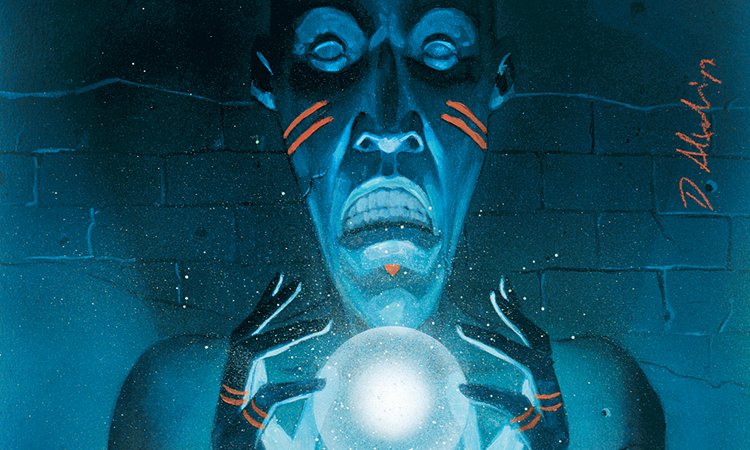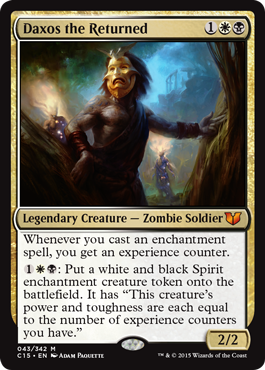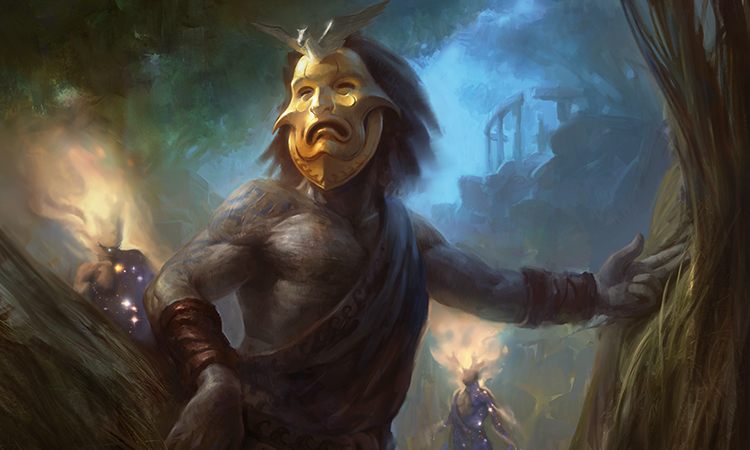Commander and Conquer
Welcome to Commander (2015 Edition) Preview Week. Players on social media have been clamoring for news on this product for months now, so I'm happy for us to finally get a whole week to talk about it. As always, I'm going to focus on the design of the set, but I'm going to pull back a little bit to talk about how the Commander product line requires a larger plan. I'm going to walk through many of the key features of the design and, of course, show off a cool preview card (a commander no less).
Design of Things to Come
One of the things I normally do when I start off a design column is introduce you to the design team, but Ben Hayes, the lead developer of Commander (2015 Edition), also has an article up today and he already made those introductions (guest columnists are asked to turn their articles in sooner than regular columnists. So if you'd like to see a full rundown on the design (and development) team, click here. I do though want to spend a little time introducing one person though, because he's very central to today's story. That person is a man named Dan Emmons, C15's lead designer. (The rest of the design team was Ethan Fleischer, Chris Tulach, James Hata, and Kelly Digges.)
The first time I ever meant Dan was when he came to my desk to introduce himself. "Hi, my name is Dan. I started today in Game Support (what was once called Customer Service—of Unglued headache fame). I want to know what I need to do to become a full-time Magic designer."
Dan is not the only person to ever do this, but he is the only one (so far) who would eventually end up accomplishing his task of becoming a full-time Magic designer. It turns out Dan had actually first made a name for himself helping out the finalists during the Great Designer Search 2. That event had a big community component where the candidates were required to work with members of the public to design cards. Both Ethan Fleischer and Shawn Main (the winner and first runner-up in the GDS2, who had both become full-time Magic designers themselves) already knew Dan.
Dan attended playtests. He came to the design seminars Mark Gottlieb runs. He submitted cards for holes that development had created. The success with these ventures led to him being put on a design mini-team, and then a supplemental design team, and then an expansion design team, at which point we realized that Dan had what it took to become a full-time Magic designer. Once Dan was a full-time designer, he started getting put on more design teams. Eventually it was time for Dan to lead his first design, which brings us to C15.
Seeing the Big Picture
Because the Commander decks are an annual product, we have to treat their design a little differently from other supplemental products. It requires more of a big-picture view, as we don't want Commander decks in sequential years to feel too similar to one another.
For those unfamiliar with the Commander decks, let me quickly run through the basics of what the decks always offer. There are five 100-card singleton (meaning no repeating of any card other than basic land) decks. There is always a main commander that matches that year's color theme, is brand new, and is the featured card of the deck, appearing on the deck box usually through a window. The decks always have a second brand new alternate commander and a third legendary creature that traditionally has been a reprint. The decks have some number of brand new cards, including a new keyword and new cycles designed to be Commander-friendly, and a bunch of reprinted cards. Each deck has a mechanical theme tied to its main commander.

Aura of Silence | Art by D. Alexander Gregory
From a design standpoint, this boils down to a few key issues that have to be figured out each year:
#1—What color are the decks?
The product has five decks, which intrinsically connects it to Magic's color wheel. That means there's a limited number of options available to design:
• Monocolor decks (white, blue, black, red, green)
• Two-color ally decks (white-blue, blue-black, black-red, red-green, green-white)
• Two-color enemy decks (white-black, blue-red, black-green, red-white, green-blue)
• Three-color Shard decks (green-white-blue, white-blue-black, blue-black-red, black-red-green, red-green-white)
• Three-color Wedge decks (white-black-green, blue-red-white, black-green-blue, red-white-black, green-blue-red)
• Four-color decks (white-blue-black-red, blue-black-red-green, black-red-green-white, red-green-white-blue, green-white-blue-black)
• Five-color decks (all white-blue-black-red-green)
• Miscellaneous (there are some other quirkier combinations that we've brainstormed)
#2—What is the twist on Commander?
Each year, we want to introduce one new tweak on the Commander format. This tweak wants to be pretty splashy, as it's one of the big selling points of the decks. Design has spent some time figuring out what twists we might be able to do and we've created a decent size list.
#3—What is the new Keyword?
The idea behind the new keyword is that it is something that plays more into how the Commander format functions. Ideally we want to create something that we would most likely never make in a traditional set—as those focus on two-player play—thus allowing us to tap into new design space.
As Commander (2015 Edition) is only the fourth set of Commander decks, that means we wanted to avoid the color combinations, commander tweaks, and keywords of the previous three sets:
Commander
Color Combination: Wedge decks
Commander Tweak: None (just doing a Commander deck product was enough for the first time out)
New Mechanic/Ability Word: Join Forces (players other than the caster may join in by using mana to make the spell, which affects everyone, bigger)
Commander (2013 Edition)
Color Combination: Shard decks
Commander Tweak: Command zone interactions (the commanders had designs that took advantage of the command zone and commander recasting rules)
New Mechanic/Ability Word: Tempting Offer (the caster is allowed to do something beneficial and then each opponent is allowed to do the same thing, but at the cost of the caster getting to do it again)
Commander (2014 Edition)
Color Combination: Monocolor decks
Commander Tweak: Planeswalker commanders
New Mechanic/Ability Word: Lieutenant (a creature that gets a bonus as long as you control your commander)
That meant of the above list of color options, the following remained:
• Two-color ally decks
• Two-color enemy decks
• Four-color decks
• Five-color decks
• Miscellaneous
This was Dan's first time leading a design, so he wanted to make sure he was choosing a color combination that wouldn't be too problematic. Four- and five-color decks, as well as the miscellaneous decks, all came with a lot of potential issues, so Dan opted out of them. That left a two-color option. Dan and his team could choose ally or enemy. After doing some research, it became clear that the Commander format was much more in need of enemy-color commanders, because early Magic had leaned heavily towards ally color cards. Also, although less of a driver, C15 was allowed to make use of Khans of Tarkir for reprint cards, and that set had two-color enemy cards in it.
Tweak in Review
Once two color-enemy decks were chosen. The next step was figuring out what the tweak would be. Dan used an early design team meeting to do some brainstorming. The team filled up a white board with all sorts of ideas, but the one that the team was most attracted to was the idea of doing "level ups." Level up was a mechanic from Rise of the Eldrazi where creatures came in three different states and the player could use mana to level them up over time, making them bigger and giving them better abilities.
One of the things Dan was very eager to do was make sure that these decks pushed towards completion. The Commander format is known for having games that can potentially run as long as three or four hours, so Dan wanted to make sure to pick abilities that helped accelerate the conclusion. Dan liked the idea of level up, because it made the commanders more powerful over time.
There was one small problem, though: Commanders get killed. A lot. Because the decks are built around these creatures, it is often advantageous to get rid of them. The Commander format addresses this by having commanders go to the command zone instead of the graveyard, allowing you to recast them (at a slightly higher cost). Level up could prove very frustrating if you spent a lot of time, energy, and mana to build up your commander only to watch it die and force you to start all over again.
Solving that problem led the team to the idea of experience counters. Rather than going on the creatures themselves, the experience counters are given to you, the player. That way if a commander dies and has to be recast, he or she comes back into play at the power level the commander left the battlefield with. This would allow players to level up their commanders without fear of them being reset. This helped Dan with his quest to make sure the games pushed towards completion.
Experience counters will probably be easier to understand with an example. Luckily (okay, more of a planned thing), my preview card for today uses experience counters. Let's take a look at Daxos the Returned.
Click to Show

As you can see, Daxos creates experience counters whenever you cast an enchantment. Those counters don't go onto Daxos, but rather they are given to the player. Then when Daxos uses his second ability to create enchantment creature tokens, their power and toughness is tied to the number of experience counters you have. Thus, with each new enchantment you cast, your enchantment creature tokens get bigger and bigger. And if Daxos ever dies and then returns (it is in his name), all the experience counters he previously generated are still available because you, the player, have them. This also means the enchantment creature tokens stay alive even when Daxos is not on the battlefield.
Deck Checks
Once the design team knew the tweak they wanted to use, the next thing for them to figure out was what theme each deck would have. There were five designers and five decks, so each designer was responsible for one of the decks. Once Dan knew they were going to be building enemy color decks, he let his team each choose one (Dan had the red-white deck, Ethan the green-blue deck, Chris the white-black deck, James the black-green deck, and Kelly had the blue-red deck) and then asked them to find two mechanical themes that could possibly work for each deck. One was chosen as the primary theme and the other became a secondary theme. The main commander would match the primary theme and the other new commander in the deck would match the secondary theme. That would give the decks some flexibility, both for gameplay and to allow the player to fiddle if they wished.
Once they had their themes, Dan then had a second angle he wanted to take with each deck. Dan had been on the previous Commander design team (for Commander (2014 Edition)) and he really liked the creative throwback theme that was used. His idea was for each deck to revisit old characters and old worlds so that we could peek in on them. Dan knew that Magic had visited many worlds, only a fraction of which we'll be able to revisit, so he saw this as a chance to allow some Vorthos love for some more minor elements of Magic's past. Kelly Digges, the creative representative on the set who served on both design and development, was put in charge of figuring out which characters and worlds made the most sense for a revisit.
The trick was to find old elements that played into the mechanical themes they already had for the decks. Let me use Daxos as an example, since he's my preview card. The team liked having a primary theme of enchantments matter. Obviously Theros is the world to revisit if you want to care about enchantments—and Kelly realized that Daxos, as a returned, would now be white-black rather than white-blue and thus fit the deck. For those unfamiliar, Daxos was a character in the Theros story who got very close to Elspeth, but unfortunately died and got sent to the underworld. Daxos the Returned is a chance for us to check back in both on the character of Daxos and the world of Theros.

Daxos the Returned | Art by Adam Paquette
There are a bunch more previews this week, so I don't want to spoil any surprises, but suffice to say that each deck is enemy color and has its main commander as a character from Magic's past that we are revisiting, along with a theme that matches that character and the world they are from.
Finding a Good Mechanic
The last major thing the design team needed to do was find a new keyword mechanic or ability word. Dan, once again, was driven to find something that could help end games. His personal goal, which he monitored through playtests, was to get the games between the decks to last less than an hour and a half. As such, he leaned towards mechanics that helped push the game towards completion.
The mechanic they ended up with, called myriad, was actually designed by Chris Tulach as a design for a single red creature for his deck. Whenever the creature attacked, it created token copies so that it could attack all the opponents at once. The team really liked the card, and realized that they could stretch it into an entire mechanic (called "mirror blitz" in design).
Myriad accomplished three important things. One, it helped end games, as it could damage all the opponents and thus helped further Dan's larger agenda. Two, it helped offset a problem creatures naturally have in Commander, in that attacking a single player hurts you politically. And three, it was pretty sexy. Having your creature turn into a whole bunch of copies for the attack was both novel and fun. It also wasn't something that we would do in normal two-player Magic.
Multiplay's the Thing
That's all I have for today. I hope all of you who have been clamoring for some news about Commander (2015 Edition) are happy. As always, I'm interested in hearing your feedback. You can email me or contact me through any of my social media accounts (Twitter, Tumblr, Google+, and Instagram).
You won't be able to join me next week, as Magic Online is taking over the site for a week, but I'll be back the week after with a new mailbag column.
Until then, may your experience lead you to victory in your future Commander games.
"Drive to Work #274—Fate Reforged, Part 2"
This podcast is part two of my five-part podcast on the design of Fate Reforged.
"Drive to Work #275—Fate Reforged Part 3"
This podcast is part three of my five-part podcast on the design of Fate Reforged.
- Episode 275 Fate Reforged Part 3 (14.8 MB)
- Episode 274 Fate Reforged, Part 2 (15.7 MB)
- Episode 273 Fate Reforged, Part 1 (21.6 MB)
- Episode 272 ARC System (17.9 MB)
- Episode 271 Un-Rules Manager (16.7 MB)

